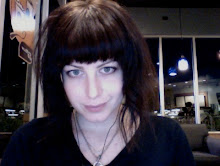
My mother was born in 1950, the second daughter to a family of three. She is the typical middle child, being somewhat left to her devices while attention was lavished on the oldest, and youngest daughters. Not only was she the middle child, forced as Freud would say, to give up her mother to a stranger, a younger sibling, when she was only two years old, but she also missed out on any affection and bonding with her own mother. My grandmother was somewhat incapable of showing love, or nurturing, and in fact my mother was never told that she was loved when she was a child.
During the early forming stages of identity my mother must have searched for something to emulate, someone to identify and someone to long for as an object. Freud said that "it is clear that in their play children repeat everything that has made a great impression on them in real life, and that in doing so they abreact the strength of the impression and ... make themselves master of the situation"(433). My mother was lonely, so she created imaginary friends to play with alone in her room when she was little, taking the matter of her loneliness into her own hands. Her imaginary friends captivated her attention and alleviated her loneliness, and at that early age they seemed so real to her that even now it is hard for her to imagine they were merely a projection of what she wanted onto empty space.
Because my mother never received the type of identity-forming nurturing from her mother and father, two parents who really had no idea how to express emotions to their own children, she became stunted. This had a major effect on my mothers growth and development as she reached adulthood, because "anxiety about entry into an adult world perceived as threatening of a too fragile sense of self or anxiety that awakens either troubling memories or drive energies will propel some people to fixate at an early state of development. They will remain attached to early forms of emotional life and sexual activity.."(Rivkin 390). My mother has always suffered from a "too fragile sense of self", and this has resulted in numerous problems. (low self-esteem, drug addiction and alcoholism, inability to act selflessly, or be faithful, and problems relating to other human beings, including her own children, ect.)
So how has it affected me? Having seen my mother through eyes of a child and an adult now, I realize that I must have sensed that she was a fragile person. Whether because I chose to emulate my father, rather than my mother, or because I chose to emulate the opposite of my mother, I have tried to grow into a person that was almost too sure of self. It has always been important for me to at least believe that I am dependent and strong, but it is also possible that this sense of independence is some sort of counter I have invented to pacify myself. Maybe my mother was not the able-bodied nurturer either, because she lacked the example that she should have seen in her own mother. I am close with her, but because she never learned how to be a mother truly. she has instead always taken the place of a best-friend, someone I was very very close to but did not offer the unconditional emotional support. At times I've been angry with her because of this, but I realize her inability to truly relate to her children with unconditional love as their mother is not really her own fault, but the fault of her own family that never accepted her unconditionally.
"Part Five Psychoanalysis and Psychology." Literary Theory : An Anthology. Ed. Julie Rivkin. By Michael Ryan. 2nd ed. Grand Rapids: Blackwell Limited, 2008.


